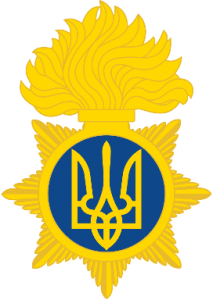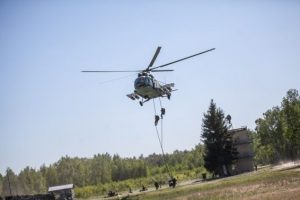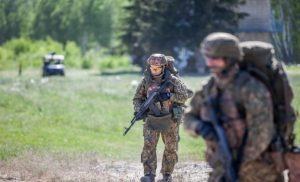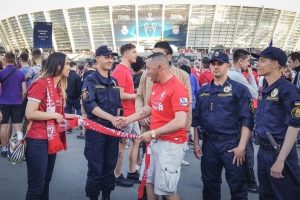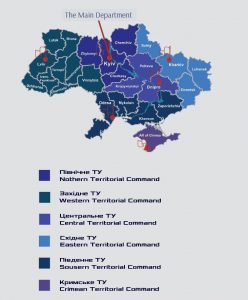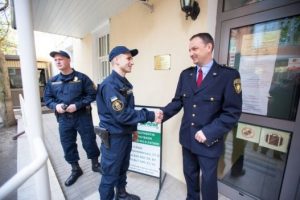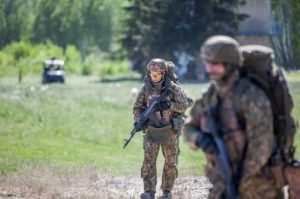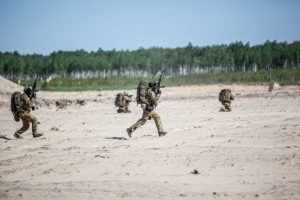The National Guard of Ukraine
The first gendarmerie-like formation that functionally resembles that of the modern days appeared on the territory of the present day Ukraine back in 17th century. In 1668 the Ukrainian Hetman (senior political and military leader of the Zaporozhian Host) ordered the establishment of the Court Guard that consisted of Dragoon and Court Protection Companies and was responsible for the protection of peace and security. The Court Guard was authorized to apprehend those who were causing disruptions or violating law and order.
The first historic mention about the National Guard in modern day Ukraine was recorded back in 1848 when the government of Austro-Hungarian Empire yielded to the growing pressure of revolution and agreed to create an armed law-enforcement formation in separate territories of its Empire.
During the Soviet period the National Guard was a part of the Soviet Ministry of Internal Affairs and was known under different names.
In 1991 with the Proclamation of Independence, the modern Ukrainian State needed a robust and professional military formation with policing functions capable of protecting the newly independent State against both external and internal threats. To this end the military formation with Law-enforcement functions with direct subordination to the President of Ukraine was created. On the 4th of November 1991 a bill was signed into the Law “On the National Guard of Ukraine”. During early years of its existence, the National Guard was directly involved in the Transnistira conflict during the spring and summer of the 1991, helping to defend the border against the spill-over of the conflict to the territory of Ukraine.
In 1999 following the ill-considered decision of the Ukrainian law-makers the National Guard of Ukraine was disbanded and merged into the Internal Troops and Armed Forces of Ukraine.
Interior Troops of Ukraine was a military formation with mostly security guard and convoy missions.
In 2014 following the annexation of Crimea and external intervention in the Eastern Ukraine, there was a pressing need to have a robust and versatile both military and law-enforcement security formation. In view of this, just in the wake of the conflict on the 13th of March 2014 the Parliament of Ukraine adopted a law “On the National Guard of Ukraine”. This law, however, was included the recommendations and best-practices of the western partners that were made within the implementation of the large-scale Twinning projects. And naming of the newly-formed security formation as “National Guard of Ukraine” was one of European recommendations.
This law foresees NGUs organizational structure, its mission, its jurisdiction and its subordination. The military formation with law-enforcement functions was given broader military capabilities and augmented with heavy weapons and armoured vehicles to better confront military aggression. This type of versatile formation with both military and police functions revealed itself to be the most suitable to deal with the hybrid threats.
Modern National Guard of Ukraine
The National Guard of Ukraine is a military formation with law enforcement functions. It is a part of the system of Ministry of Internal Affairs of Ukraine and is designed to fulfil the tasks related to protection and safeguarding the life, rights, freedoms and legitimate interests of citizens, society and the state from criminal and other wrongful infringements, and also maintenance of public order and public security, as well as to ensure, in coordination with law enforcement agencies, the national security and protection of national borders, stopping terrorist activities and activities of illegitimate paramilitary or armed troops (groups), terrorist organizations, organized groups and criminal organizations.
The National Guard of Ukraine is a part of the system of the Ministry of Internal Affairs of Ukraine. The Commander of the National Guard of Ukraine reports to the Minister of Internal Affairs. He is assigned by the President of Ukraine on the proposal of the Minister of Internal Affairs.
NATIONAL GUARD OF UKRAINE
MAIN FUNCTIONS:
1. To protect the constitutional system of Ukraine and its territorial integrity from violent attempts to transform them.
2. To maintain public order and ensure protection of life, rights, freedoms and legitimate interests of citizens.
3. To contribute to the maintenance of public safety and public order during meetings, rallies, marches, demonstrations and other public events in case of risks to public health and safety.
4. To provide security guard support to public authorities.
5. To protect nuclear facilities, nuclear materials, nuclear waste and other sources of radioactive emission in public ownership, as well as critical infrastructure.
6. To protect special cargoes, the list of which shall be determined by Cabinet of Ministers of Ukraine.
7. To protect diplomatic missions and consulates of foreign countries, as well as representative offices of international organizations in Ukraine.
8. To participate in activities to cease armed conflicts and other acts of provocation at national borders, as well as activities to prevent massive crossing of national borders from neighbouring countries.
9. To participate in special operations to neutralize armed offenders, to stop activity of illegitimate paramilitary or armed gangs, organized groups and criminal organizations inside Ukraine, as well as measures related to counterterrorism activities.
10. To be involved in riot control efforts if there exists risk of violence against citizens.
NATIONAL GUARD OF UKRAINE STRUCTURE
1. The Main Headquarters (Kyiv).
2. Territorial Commands: Eastern, Northern, Western, Southern, Central, Crimean.
3. Directly subordinated units (to the Main Headquarters).
4. Military education and training institutions (centres).
5. Sustainment Units of the National Guard of Ukraine
According to the functions, the NGU is composed of:
1. Operational units (on a very short notice can be deployed across the whole territory of Ukraine to perform all range of missions alongside the Armed forces of Ukraine, National Police of Ukraine, State Border Guard Service of Ukraine and State Emergency Service of Ukraine);
2. Public order protection units (safeguard the life and property of people and perform riot control measures during disturbances);
3. Convoy units (escorting of the suspected or convinced criminals to the judicial authorities);
4. Special purpose units (responds to and resolves high-risk incidents, including terrorist incidents);
5. Key infrastructure protection units (provides security guard to the key governmental institution and key infrastructure);
6. Embassies and consular institutions protection units (protection of diplomatic missions and consulates of foreign countries in Ukraine);
7. NGU aviation units;
8. Sustainment units of the National Guard of Ukraine.
INTERNATIONAL COOPERATION
The National Guard of Ukraine is a relatively young structure, but it has a wealth of experience in international cooperation as well as international projects and trainings.
International projects and trainings
1. Twinning project «Implementation and development of quality management» (ref. 2008/164-748), 2008—2010.
2. Twinning project «Contribution to improvement of the system of public order protection» (ref. Ua10/enp-pca/jh/28), 2012-2013.
3. The NGU and Romanian gendarmerie joint projects: «Strengthening the institutional capacity of the National Guard of Ukraine», 2014 — 2015, «Supporting the development of the National Guard of Ukraine», 2016 — 2017, «Technical assistance for consolidating the National Guard of Ukraine», 2018.
4. Project of Ukrainian Physical Nuclear Security system inclusion to the structure of the global Physical Nuclear Security system, 2015 — 2019.
5. Annual international military exercises «Rapid Trident», «Sea Breeze».
6. European Union Police Service Training (EUPST), 2011 — 2013, 2016 — 2018.
7. Joint trainings «Fearless Guardian – 2015».
8. International exercises «RoGendIntEx».
Cooperation with the international organizations
1. Cooperation within FIEP association;
2. Cooperation with NATO;
3. Participation in Multinational Joint Committee;
4. Cooperation with EUAM (European Union Advisory Mission).
PEACEKEEPING OPERATIONS
The servicemen of the National Guard of Ukraine are actively involved in the peacekeeping activities (crisis management activities) worldwide thus contributing to Ukraine’s overall efforts in capacity of an active contributor to UN-led and UN-authorized operations.
Being deployed in the capacity of IPO (individual police officers) NGU servicemen perform policing missions in several UN-led missions (Cyprus (UNFICYP), South Sudan (UNMISS) and Democratic Republic of Congo (MONUSCO).
With the tense security situation that Ukraine faces today, resolving the conflict in the east of Ukraine and preventing further external aggression will stay on the top of the agenda and the main point of concern for defence and security institutions of Ukraine for years to come.
But the current security situation will not diminish Ukraine’s will and contribution to the global effort of promoting and protecting international peace and security. The National Guard of Ukraine will continue to provide personnel and assets to the international peacekeeping operations.
Training of the personnel
The National Guard of Ukraine pays utmost attention to the qualified and pertinent training of the personnel and its career-long professional development. Taking into consideration the fact that the National Guard of Ukraine is military formation with law-enforcement functions, the training covers both military and law-enforcement expertise and ensures that NGU members meet the applicable occupational requirements (public order, special operations etc).
Currently, the system of professional training undergoes significant transformation and reforming. And this transformation is going under the guidance of our international partners.
Military Education and Training Institutions
National Academy of the National Guard of Ukraine (Kharkiv)
Provides initial and advanced training to the officers of the National Guard of Ukraine. Training curriculum is tailored to meet the operational requirements of the National Guard of Ukraine and includes first-hand experience and lessons-learnt while performing assigned missions in the Anti-Terrorist Operation.
National Academy of the National Guard of Ukraine provides the following training: bachelor’s degree (initial training of the officer) – 4 years-long training, master’s degree – 5.5 years-long training, advanced officers training course – 2 years-long training for senior officers OF3-OF5).
International Inter-Agency Multifunctional Training Centre (Stare)
Created in 2017, the Training Centre provides tailored, mission-specific training to the units of the National Guard of Ukraine that perform all range of missions assigned to the NGU or planned to take part in the peacekeeping operations as Individual Police Officer (IPOs) or as member of the NGU Formed Police Unit (FPU). Training Centre has an extended pool of qualified instructors with the wealth of operational and international experience.
Training centre strives to provide individual and collective training to other structures of the Ministry of Internal Affairs of Ukraine (the National Police, the State Border Guard Service and the Emergency Service) as well as for international partners.
Non-commissioned officers training centre (Zolochiv)
Provides training to the NCOs of the National Guard of Ukraine depending on their position and occupational qualification. There are several courses that training centre runs: Basic training course, Basic Leadership Course (squad leader), Intermediate Leadership Course (platoon sergeant), Advanced Leadership Course (Company sergeant), K-9 handler course, military engineering course, tactical medicine operator course).
Website: www.ngu.gov.ua/


